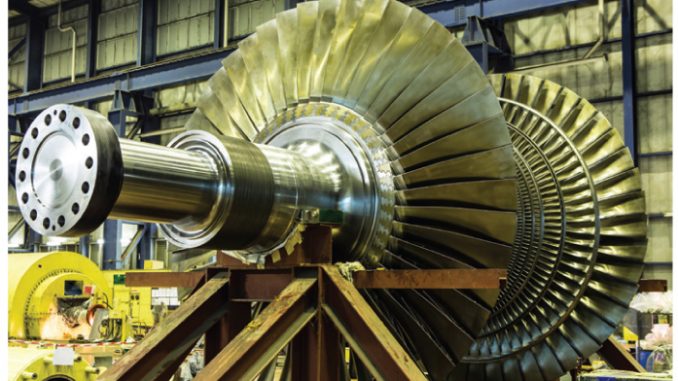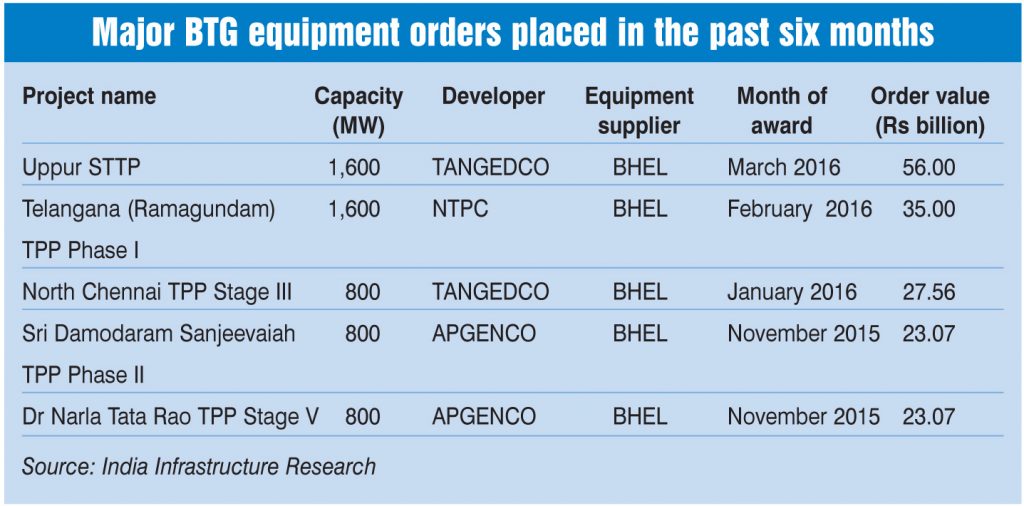
The equipment market outlook for the coal-based generation segment remains subdued, as only a handful of projects are being undertaken. Over the past six months, generation companies placed only five major boiler, turbine and generator (BTG) equipment orders, aggregating a capacity of 4,800 MW. The orders, valued at Rs 164.7 billion, were secured by Bharat Heavy Electricals Limited (BHEL). While a quick restoration of demand is unlikely, the equipment market is expected to witness a slow-paced but consistent recovery as sector growth picks up on the back of ongoing policy initiatives.
Market trends
The manufacturing capacity of Indian BTG suppliers remains highly underutilised as the average annual demand for BTG equipment has dropped to less than 10 GW annually against an aggregate annual manufacturing capacity of 30-35 GW. The annual demand has decreased sharply from the period 2007 to 2010 when orders aggregating 25-30 GW were being placed each year. The production of BTG equipment has declined due to the low orders.
BHEL, with an annual manufacturing capacity of 20 MW, has been witnessing a sharp fall in its order flow over the years. Order flows from the power sector decreased from Rs 463.93 billion in 2010-11 to Rs 248.73 billion in 2014-15.
On the bright side, BHEL has managed to win all the equipment orders placed in the past six months. This includes two orders from Tamil Nadu Generation and Distribution Corporation (TANGEDCO) for the 1,600 MW Uppur supercritical thermal power plant (TPP) and the 800 MW North Chennai supercritical thermal power station (TPS) Stage III for an aggregate value of Rs 56 billion and Rs 27.59 billion respectively. BHEL was awarded a 35 billion order by NTPC Limited for the supply of two 800 MW steam generators (boilers) for the Telangana super thermal power project. In November 2015, BHEL had also received two orders from Andhra Pradesh Power Generation Corporation (APGENCO), cumulatively valued at Rs 46.14 billion, for setting up two supercritical units of 800 MW each at the Dr Narla Tata Rao TPS Stage V and the Sri Damodaram Sanjeevaiah TPS Stage II projects. Meanwhile, other private equipment manufacturers including L&T-MHPS Boilers Private Limited, Alstom Bharat Forge Power Limited, Toshiba JSW and Thermax Babcock & Wilcox Energy Solutions Private Limited are struggling to improve their order flow.
Challenges and the way forward
In spite of the government’s efforts to review power purchase agreements and resolve the fuel supply issues, the BTG market has not recovered fully from the demand slump that started in 2011-12. The private sector generation companies continue to refrain from placing fresh orders due to the lack of demand from the cash-strapped discoms and the increasing focus on the renewable energy segment. In addition, the margins and profitability of equipment manufacturers have been significantly impacted by the intense competition, shrinking order flow and sharp rise in material costs, making it difficult to manage capital and operating costs.
Going forward, the market is expected to pick up with the new orders being placed for projects coming up in the Thirteenth Plan period. The generation capacity addition target for the plan period (2017-22) is around 100 GW. The equipment demand for the development of ultra mega power projects would further enhance the order flow during this period. Apart from new capacity addition, there are opportunities for equipment suppliers in the renovation and modernisation business as well. The Make in India initiative has also created a positive sentiment for domestic manufacturing; however, the finalisation of orders has remained poor.
In sum, the market scenario is not expected to turn around in the immediate term; however, manufacturers are hopeful that the recent policy interventions and announcement of new projects will revive demand in the medium to long term.

